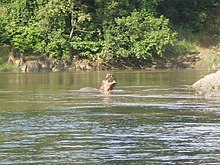Bénoué National Park
| Bénoué National Park | |
|---|---|
 | |
| Location | Cameroon |
| Coordinates | 8°20′N 13°50′E / 8.333°N 13.833°E |
| Area | 1,800 km2 (690 sq mi) |
| Established | 1968 |
Bénoué National Park is a national park of Cameroon and a UNESCO designated Biosphere Reserve.[1] It is 180,000 ha (440,000 acres) in size. The park has a wide frontage to the Bénoué River,[2] which stretches for over 100 km (62 mi), forming the eastern boundary. The public road to Tcholliré cuts across the northern part of the park. The western boundary is made up of the main road linking the towns of Garoua to the north, with Ngaoundéré to the south.[3] The park can be accessed coming north from Ngaoundéré.[4]
History[edit]
In 1932, the area was established as a Faunal Reserve. It was upgraded to a National Park in 1968, and became a Biosphere Reserve in 1981.[3]
Geography[edit]
The park is located in northeastern Cameroon in the Bénoué Department. It lies in the Bénoué savanna belt, a humid savannah woodland area [5] between the cities of Garoua to the north and Ngaoundéré to the south. The main river is the Bénoué River,[2] which stretches for over 100 km (62 mi), forming the park's eastern boundary. The park's altitude ranges from 250 to 760 m (820 to 2,490 ft) above sea level. The higher elevations are characterized by large rocky massifs, while the undulating plain and forest characterize the lower sections.[3] Eight hunting reserves, totaling 520,378 ha (1,285,880 acres), surround the park except along the main road.[1]
Flora and fauna[edit]

The habitat in Bénoué National Park is characterized by wooded grassland. It includes several types of Sudanian woodland such as Isoberlinia-dominated and other woodland in the south-centre, to shorter, more open, mixed wooded grassland in the north, dry Anogeissus forest, semi-evergreen riparian forest and thickets along the Bénoué and its major affluents.
African elephant, spotted hyena, waterbuck, warthog and monkeys are also found in the park. The predominant large ungulates in the park are antelope such as the kob, western hartebeest, giant eland and waterbuck, as well as African buffalo. The only place in Africa where there is a realistic chance to view the giant eland, Africa's largest antelope, is within Bénoué National Park.[4] The African wild dog is present within the national park, though less common here than in Faro National Park.[6] Bénoué National Park is known for its hippopotamus colonies.[2] Along with hippo, crocodile are common in the rivers.
Since 2005, the protected area is considered a Lion Conservation Unit.[7] In 2011, the lion population was estimated at 200 adult individuals.[8][9]
Bénoué National Park is an Important Bird Area (#CM007) with recent surveys identifying 306 species. In the dry season, sandbars exposed by fluctuating levels of the sandy Bénoué River provide habitat for plover and other waterbirds.[3] Common species include Adamawa turtle-dove, crocodile bird, red-throated bee-eater, red-winged grey warbler, stone partridge, and violet turaco.[10]
Population[edit]



The majority of the population within the park is nomadic. There is a loose social structure that park guards and conservationists deal with, taking on roles such as community educators and arbitrators.[1] At least one incident of kleptoparasitism, villagers stealing meat from a lion kill, was documented at Bénoué National Park.[11]
See also[edit]
References[edit]
- ^ a b c Nchami, John (September 18, 2010). "Putting the park in the hands of the people". Science in Africa. Archived from the original on 29 November 2010. Retrieved 19 September 2010.
- ^ a b c "WILDLIFE NATIONAL PARKS". Consulate of the Republic of Cameroon - Sydney, Australia. Archived from the original on 18 February 2011. Retrieved 19 September 2010.
- ^ a b c d "BirdLife IBA Factsheet CM007 - Bénoué National Park". BirdLife International. Retrieved 19 September 2010.
- ^ a b Hudgens, Jim; Trillo, Richard (2003). The rough guide to West Africa. Rough Guides. p. 1241. ISBN 978-1-84353-118-0.
- ^ Antelopes: global survey and regional action plans. Union internationale pour la conservation de la nature et de ses ressources. Antelope Specialist Group, IUCN. 1990. p. 159. ISBN 978-2-8317-0016-8. Retrieved 19 September 2010.
- ^ Woodroffe, R.; Ginsberg, J. R.; Macdonald, D. W. (1997). The African wild dog: status survey and conservation action plan. IUCN/SSC Candid Specialist Group. pp. 20–22. ISBN 978-2-8317-0418-0.
- ^ IUCN Cat Specialist Group (2006). Conservation Strategy for the Lion West and Central Africa. Yaounde, Cameroon: IUCN.
- ^ Croes, B.M.; Funston, P.J.; Rasmussen, G.; Buij, R.; Saleh, A.; Tumenta, P.N.; De Iongh, H.H. (2011). "The impact of trophy hunting on lions (Panthera leo) and other large carnivores in the Bénoué Complex, northern Cameroon". Biological Conservation. 144 (12): 3064–3072. doi:10.1016/j.biocon.2011.09.013.
- ^ Schoe, M.; De Iongh, H. H.; Croes, B. M. (2009). "Humans displacing lions and stealing their food in Bénoué National Park, North Cameroon". African Journal of Ecology. 47 (3): 445–447. doi:10.1111/j.1365-2028.2008.00975.x.
- ^ "Bird Watching in Cameroon". Archived from the original on 19 September 2010. Retrieved 19 September 2010.
- ^ Walker, M. (2009). "Lions in Cameroon are having their kills stolen from under their noses by hungry villagers". BBC. Retrieved 19 September 2010.
Further reading[edit]
- Mayakaa, T. B. (2002). "Wildlife Co-Management in the Benoue National Park-Complex, Cameroon: A Bumpy Road to Institutional Development". World Development. 30 (11): 2001–2016. doi:10.1016/s0305-750x(02)00111-0.
- Mayakaa, T. B.; Stigter, J.D.; Heitkönig, I. M.A.; Prins, H. H.T. (2004). "A population dynamics model for the management of Buffon's kob (Kobus kob kob) in the Bénoué National Park Complex, Cameroon". Ecological Modelling. 176 (1−2): 135–153. doi:10.1016/j.ecolmodel.2003.09.038.
- Stark, M. A. (1986). "Relationship between fire and basal scarring on Afzelia africana in Benoue National Park". Cameroon African Journal of Ecology. 24 (4): 263–271. doi:10.1111/j.1365-2028.1986.tb00370.x.
External links[edit]
- BirdLife International. "Important Bird Areas factsheet: Bénoué National Park".


 French
French Deutsch
Deutsch

